Osprey Roundup
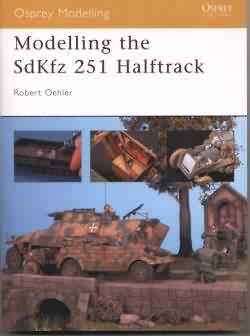 Osprey
Modelling 6, Modelling the SdKfz 251 Halftrack, by Robert Oehler, ISBN
1-84176-706-9, 80 pages. Osprey
Modelling 6, Modelling the SdKfz 251 Halftrack, by Robert Oehler, ISBN
1-84176-706-9, 80 pages.
Here is a very good book on modelling the 251. It begins with a brief
introduction listing the four Ausfuehrungs with their differences and
also gives a table of the 23 variants. Then there’s a chapter on
airbrushing which novices will find very helpful. The first modelling
chapter is on the 1/76 scale Hasegawa 251/1 Ausf D at intermediate level.
It’s built out of the box to show how to airbrush the camouflage
and weathering. Next at intermediate level is the Tamiya 251/1 Ausf C.
This shows how to improve the kit sprockets and roadwheels and adds many
details. The painting section gives notes on how and when to apply washes.
The advanced build converts Tamiya’s 251/1 Ausf D to a late 251/9
Stummel with its gun mounted on the hull roof. The gun and some other
parts come from DML’s SdKfz 250/8, with Modelkasten tracks and many
other aftermarket accessories. Although since it was written we have
seen a kit of this version announced this chapter will give modellers
of that kit an excellent guide to improve and detail it. The painting
section here shows how to make and apply mud. At master level there’s
a 251/7 D engineer halftrack with assault bridge sections, a conversion
of the same Tamiya kit. A number of aftermarket conversions and detail
sets are used from Royal Models, Verlinden and others plus the R&J
engine and engine bay set. The special technique used here is soldering,
shown very clearly. This section alone is worth the cost of the book!
Finally there’s how to build a diorama base. This uses a Verlinden
Productions base with a paved road, roadside shrine, culvert and stream,
grassy areas, and a tree. This is a great guide to base-building for
anyone who’s not tried grass or water before or is unhappy with
the results they’ve achieved.
Highly recommended!
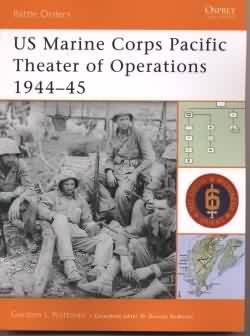 Battle
Orders 8, US Marine Corps Pacific Theater of Operations 1944-45, by Gordon
L Rottman, ISBN 1-84176-659-3, 96 pages. Battle
Orders 8, US Marine Corps Pacific Theater of Operations 1944-45, by Gordon
L Rottman, ISBN 1-84176-659-3, 96 pages.
This book starts with an account of the Corps’ expansion to almost
half a million men and women. The new structure is described in detail,
including the divisional organisation. Changes in tactics are examined,
looking at multi-division assault landings and the use of flamethrowers,
and the then-new and improved command and control methods are described.
The remaining two-thirds of the book describes combat operations, the
assaults on Guam, Peleliu, Iwo Jima, and Okinawa. Each landing and the
subsequent fighting are described and clearly shown on very good maps.
Highly recommended.
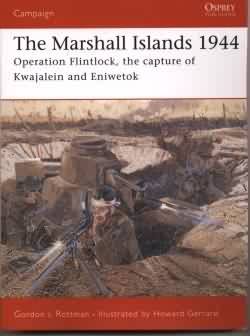 Campaign
146, The Marshall Islands 1944 Operation Flintlock, the capture of Kwajalein
and Eniwetok, by Gordon L Rottman, illustrated by Howard Gerrard, ISBN1-84176-51-0,
96 pages. Campaign
146, The Marshall Islands 1944 Operation Flintlock, the capture of Kwajalein
and Eniwetok, by Gordon L Rottman, illustrated by Howard Gerrard, ISBN1-84176-51-0,
96 pages.
The Marshall Islands were an important stepping stone for the Allied
advance on Japan, although as it turned out they were not as heavily
fortified by the Japanese as was thought before the war. The Marshalls
are coral atolls, with each having a number of small islands though only
a few were actually garrisoned by the Japanese. The rival plans for attack
and defence are described, and there are notes on the opposing commanders
and their forces. The various landings are described in good detail,
at Majuro Atoll on 30 January 1944, at the Kwajalein Atoll on Roi, Namur,
and Kwajalein Islands on 1 February, and at Eniwetok Atoll on Engebi,
and Eniwetok Islands on 17 February. The course of the assault on each
is also shown in excellent maps and bird’s-eye views.
Recommended!
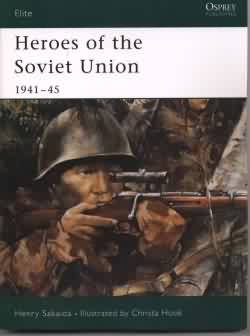 Elite
111, Heroes of the Soviet Union 1941-45, by Henry Sakaida, illustrated
by Christa Hook, ISBN 1-84176-769-7, 64 pages. Elite
111, Heroes of the Soviet Union 1941-45, by Henry Sakaida, illustrated
by Christa Hook, ISBN 1-84176-769-7, 64 pages.
This starts with the origins of the German-Soviet war and details the
HSU award itself with a breakdown of its recipients by ethnic group and
nationality. Details of 29 actions that resulted in HSU awards are given,
mostly dealing with individuals but some that produced awards to several
are lumped together. Air Force, Navy, infantry, tankers, snipers, spies,
and partisans are included, and their stories make fascinating reading.
The photographs are of course mostly studio shots, but they do include
men not mentioned in the text with brief details of the actions that
resulted in their awards.
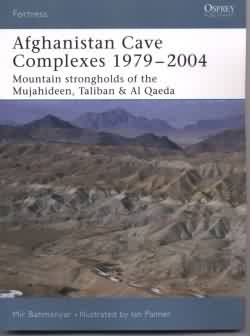 Fortress
26, Afghanistan Cave Complexes 1979-22004, Mountain Strongholds of
the Mujahideen, Taliban & Al Qaeda, by Mir Bahmanyar, illustrated
by Ian Palmer, ISBN 1-84176-776-X, 64 pages. Fortress
26, Afghanistan Cave Complexes 1979-22004, Mountain Strongholds of
the Mujahideen, Taliban & Al Qaeda, by Mir Bahmanyar, illustrated
by Ian Palmer, ISBN 1-84176-776-X, 64 pages.
This is a very interesting book. The cave complexes are hard to spot,
even from the air, due to excellent concealment, and many have multiple
entrances that make them extremely difficult to block completely even
when successfully attacked. Their use as bases, shelters, etc, is described
with an analysis of the tactics used to attack them. The colour plates
include cutaways of some complexes and bird’s-eye views of attacks
on them, and the many colour photographs give a vivid impression of the
terrain and its difficulties.
Recommended.
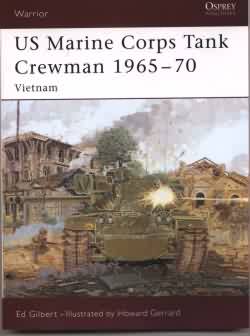 Warrior
90, US Marine Corps Tank Crewman 1965-70, Vietnam, by Ed Gilbert, illustrated
by Howard Gerrard, ISBN 1-84176-718-2, 64 pages. Warrior
90, US Marine Corps Tank Crewman 1965-70, Vietnam, by Ed Gilbert, illustrated
by Howard Gerrard, ISBN 1-84176-718-2, 64 pages.
This book covers the Viet Nam service of three fictional USMC tankers,
from enlistment and training through to combat. The combats described
are, however, not fiction. After a brief introduction to Marine service
in Viet Nam our three characters are introduced, with accounts of their
backgrounds and how they came to enlist as well as of their training.
The USMC’s traditions and how they are passed on to recruits come
next, followed by a chapter on uniforms with very useful comments on
actual dress in Viet Nam. Then there’s everyday life in Viet Nam,
from the replacement depot to a tank company. We get an exceptional insight
into what it was like to serve with the tanks on bridge guard, convoy
escort, the reaction platoon and search and destroy operations. The final
chapter is on the Tet Offensive, with an excellent description of the
fighting in Hue. The good colour plates are backed up by an excellent
selection of photographs.
Very highly recommended!
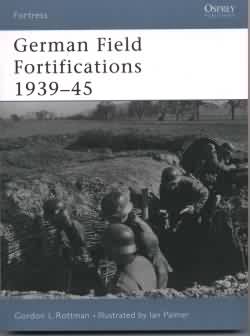 Fortress
23, German Field Fortifications 1939-45, by Gordon L Rottman, illustrated
by Ian Palmer, ISBN 1-84176-761-1, 64 pages. Fortress
23, German Field Fortifications 1939-45, by Gordon L Rottman, illustrated
by Ian Palmer, ISBN 1-84176-761-1, 64 pages.
Here’s a very useful book for modellers planning an armour diorama
or looking for ideas for figure vignettes. It begins with a look at German
doctrine for tactical defence, then examines how field fortifications
were planned and laid out. After that comes a chapter on the firepower
available, followed by examinations of materials, construction methods,
and the types of positions built for infantry, crew-served weapons, and
bunkers. Attention then turns to the specific problems and advantages
of fortifications in North Africa, Italy and the Eastern Front. Then
there’s a chapter on the fortifications at El Alamein, Ortona, Petsamo-Kirkenes,
and Palenberg – desert, Italy, Finland, and Germany, respectively,
and each with its own points of interest.
Highly recommended.
 Essential
Histories, The Collapse of Yugoslavia 1991-1999, by Alastair Finlan,
ISBN 1-94176-805-7, 96 pages. Essential
Histories, The Collapse of Yugoslavia 1991-1999, by Alastair Finlan,
ISBN 1-94176-805-7, 96 pages.
If the IFOR and SFOR operations interest you this is a book you will
want to read. It gives the political and military background to Yugoslavia’s
internecine fighting, amazingly complex with its interlocking network
of temporary alliances. No punches are pulled in criticism of NATO’s
inability to defend the “safe zones” due to indecision, but
some NATO generals get their deserved praise as well. The role of certain
Yugoslav politicians and gang leaders in fomenting conflict is exposed
too. This is not a “modelling” book but essential for understanding
the background.
Highly recommended.
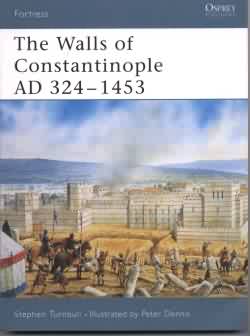 Fortress
25, The Walls of Constantinople AD 324-1453, by Stephen Turnbull, illustrated
by Peter Dennis, ISBN 1-84176-759-X, 64 pages. Fortress
25, The Walls of Constantinople AD 324-1453, by Stephen Turnbull, illustrated
by Peter Dennis, ISBN 1-84176-759-X, 64 pages.
This is a detailed examination of one single fortress, and all the better
for its concentration. It looks at the way Constantinople’s defences
evolved over the years, how they were attacked, and how they were eventually
breached. The maps and illustrations are superb! If “castles” interest
you (the quotes because this deals with a whole city) or if you plan
to visit Constantinople and would value a guide to the wall, get this
book – it even warns you which parts are not a good idea to visit
nowadays.
Very highly recommended!
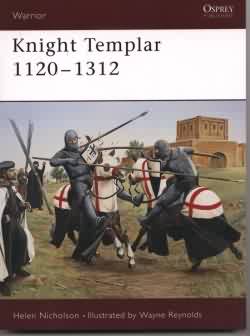 Warrior
91, Knight Templar 1120-1312, by Helen Nicholson, illustrated by Wayne
Reynolds, ISBN 1-84176-670-4, 64 pages. Warrior
91, Knight Templar 1120-1312, by Helen Nicholson, illustrated by Wayne
Reynolds, ISBN 1-84176-670-4, 64 pages.
This is one for figure modellers who like the medieval period as well
as for those who simply like knowing about armoured knights. It gives
a complete description of the origins of the Order, how its men were
recruited and sworn to service, and how they lived and fought. The illustrations
and colour plates are superb, and the text is extremely informative.
Highly recommended.
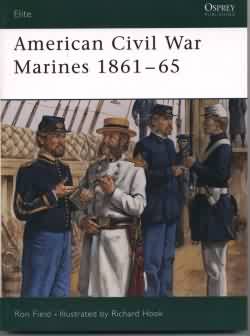 Elite
112, American Civil War Marines 1861-65, by Ron Field, illustrated by
Richard Hook, ISBN 1-84176-768-9, 64 pages. Elite
112, American Civil War Marines 1861-65, by Ron Field, illustrated by
Richard Hook, ISBN 1-84176-768-9, 64 pages.
Here’s one for all fans of the War Between The States. It deals
in detail with the Marines of both sides from their respective Corps’ foundation
to the end of the war. All their fights are described - assault landings,
defence actions, and naval combats – and there are sections on their
uniforms and equipment too. The illustrations are very well chosen to
show what they looked like, and the colour plates show both men and battles.
Highly recommended.
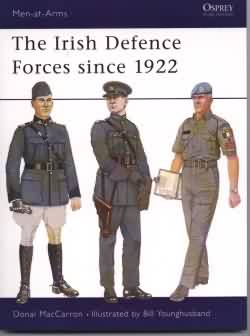 Men-at-Arms
417, The Irish Defence Forces since 1922, by Donald MacCarron, illustrated
by Bill Younghusband, ISBN 1-4176-742-5, 48 pages. Men-at-Arms
417, The Irish Defence Forces since 1922, by Donald MacCarron, illustrated
by Bill Younghusband, ISBN 1-4176-742-5, 48 pages.
This book covers a neglected facet of military dress and does it very
well. Although Irish uniforms have tended to have a distinct resemblance
to British they do have their own “spin” and on close examination
there are many differences as well as many interesting quirks – at
one period a very British-looking service dress with a helmet based on
the German WWI pattern, for instance. The period covered is from the
beginnings right up to 21st century UN peacekeeping service and Bill
Younghusband’s superb plates are backed up by well-chosen photographs.
Recommended!
|
|
 Osprey
Modelling 6, Modelling the SdKfz 251 Halftrack, by Robert Oehler, ISBN
1-84176-706-9, 80 pages.
Osprey
Modelling 6, Modelling the SdKfz 251 Halftrack, by Robert Oehler, ISBN
1-84176-706-9, 80 pages. Battle
Orders 8, US Marine Corps Pacific Theater of Operations 1944-45, by Gordon
L Rottman, ISBN 1-84176-659-3, 96 pages.
Battle
Orders 8, US Marine Corps Pacific Theater of Operations 1944-45, by Gordon
L Rottman, ISBN 1-84176-659-3, 96 pages. Campaign
146, The Marshall Islands 1944 Operation Flintlock, the capture of Kwajalein
and Eniwetok, by Gordon L Rottman, illustrated by Howard Gerrard, ISBN1-84176-51-0,
96 pages.
Campaign
146, The Marshall Islands 1944 Operation Flintlock, the capture of Kwajalein
and Eniwetok, by Gordon L Rottman, illustrated by Howard Gerrard, ISBN1-84176-51-0,
96 pages. Elite
111, Heroes of the Soviet Union 1941-45, by Henry Sakaida, illustrated
by Christa Hook, ISBN 1-84176-769-7, 64 pages.
Elite
111, Heroes of the Soviet Union 1941-45, by Henry Sakaida, illustrated
by Christa Hook, ISBN 1-84176-769-7, 64 pages. Fortress
26, Afghanistan Cave Complexes 1979-22004, Mountain Strongholds of
the Mujahideen, Taliban & Al Qaeda, by Mir Bahmanyar, illustrated
by Ian Palmer, ISBN 1-84176-776-X, 64 pages.
Fortress
26, Afghanistan Cave Complexes 1979-22004, Mountain Strongholds of
the Mujahideen, Taliban & Al Qaeda, by Mir Bahmanyar, illustrated
by Ian Palmer, ISBN 1-84176-776-X, 64 pages. Warrior
90, US Marine Corps Tank Crewman 1965-70, Vietnam, by Ed Gilbert, illustrated
by Howard Gerrard, ISBN 1-84176-718-2, 64 pages.
Warrior
90, US Marine Corps Tank Crewman 1965-70, Vietnam, by Ed Gilbert, illustrated
by Howard Gerrard, ISBN 1-84176-718-2, 64 pages. Fortress
23, German Field Fortifications 1939-45, by Gordon L Rottman, illustrated
by Ian Palmer, ISBN 1-84176-761-1, 64 pages.
Fortress
23, German Field Fortifications 1939-45, by Gordon L Rottman, illustrated
by Ian Palmer, ISBN 1-84176-761-1, 64 pages. Essential
Histories, The Collapse of Yugoslavia 1991-1999, by Alastair Finlan,
ISBN 1-94176-805-7, 96 pages.
Essential
Histories, The Collapse of Yugoslavia 1991-1999, by Alastair Finlan,
ISBN 1-94176-805-7, 96 pages. Fortress
25, The Walls of Constantinople AD 324-1453, by Stephen Turnbull, illustrated
by Peter Dennis, ISBN 1-84176-759-X, 64 pages.
Fortress
25, The Walls of Constantinople AD 324-1453, by Stephen Turnbull, illustrated
by Peter Dennis, ISBN 1-84176-759-X, 64 pages. Warrior
91, Knight Templar 1120-1312, by Helen Nicholson, illustrated by Wayne
Reynolds, ISBN 1-84176-670-4, 64 pages.
Warrior
91, Knight Templar 1120-1312, by Helen Nicholson, illustrated by Wayne
Reynolds, ISBN 1-84176-670-4, 64 pages. Elite
112, American Civil War Marines 1861-65, by Ron Field, illustrated by
Richard Hook, ISBN 1-84176-768-9, 64 pages.
Elite
112, American Civil War Marines 1861-65, by Ron Field, illustrated by
Richard Hook, ISBN 1-84176-768-9, 64 pages.